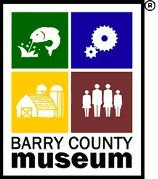In the latter part of January, 1896, J . M. Bayless called a meeting of six or eight citizens of Cassville to consult about the advisability of soliciting subscriptions for the building of a line to connect to the Frisco. C.D. Manley, Charles Ray and W.L. Martin were appointed to a soliciting committee. In a short time the necessary funds were contributed, the surveys made, right-of-ways secured and the work began. Laying of the rails began June 11, 1896 at Exeter and were laid into Cassville on June 20, and Cassville had a railroad. The name of the little shortline which was to be the connecting link was The Cassville and Western Railroad.
The actual length of the track when completed in July, 1896, was five miles and four hundred feet. One spur ran to the Cassville Roller Mill and another along the alley between the original town and the Bayless addition. Its rolling stock consisted of two engines, a boxcar, passenger coach and a combination baggage and passenger coach. A roundhouse and a depot, described in 1896 as "commodious and tasty" were constructed in Cassville. The depot was later to also house the telephone company.
The new railroad company was incorporated under the state laws March 14, 1896 with the following stockholders: J.M. Bayless, Mrs. M.A. Bayless, Dr. D.L. Mitchell, Cassville; T.A. Miller, Aurora; J.R. Rincker, Bowling Green, Missouri; and E.R. Clark, Topeka, Kansas. J.M. Bayless was president and general manager. Its capital stock was $50,000.
For several years the railroad was the only entry into Cassville other than roads that were impassable during bad weather. Both passengers and shippers depended upon it for transportation from the Frisco line at Exeter into Cassville.
The bankrupt short line was purchased by two Cassville businessmen, Dave Dingler and James C. Ault in 1919. The new owners announced that the little railroad had a new name, and would henceforth be known as The Cassville and Exeter Railroad, or the C. &E. Dave Dingler was the railroad's president and was also the full-fledged, full-time locomotive engineer. Under his guidance the little line was soon showing not only a healthy profit, but receiving publicity in newspapers from coast to coast. Every summer tourists visited the C & E in large numbers , and the ride over to Exeter and back in the shining passenger car was a "must" for local folks on an outing too.
The little railroad continued to be highly publicized and became Cassville's "claim to glory." In 1931 it was featured in Robert Ripley's "Believe It Or Not." In 1937 pictures and a story about the short-line and its colorful president appeared in Newsweek magazine. The St. Louis Post-Dispatch carried a story in 1927 entitled, "President of Railroad Also Its Only Engineer." The New York Times on December 12, 1926, featured Dingler and the railroad in its Rotogravure Picture section. The July issue of the transportation industry's monthly magazine Transportation in 1928 featured the "Family Railroad in Missouri." The Springfield Press in May, 1930 carried the story "Railroad President Pilots Engine Over Shortest Line in America." The St. Louis Globe Dem ocrat in February 1939 carried an Associated Press story called, "Cassville's Unique Freight Train Runs Uphill and Coasts Back." The Railroad Man's Magazine in November, 1930, featured "Our Shortest Railroad," the story of the C & E. And there were many, many more. The C & E was famous and the publicity had made Dave Dingler a world figure in the railroad business.
Finally, on September 11, 1956, the locomotive made the last run over the 4.8 mile long track from Cassville to Exeter to return an empty boxcar to the Frisco Line at Exeter. The C & E had served the Cassville community faithfully for 60 years. For much of that time, in the early years of Cassville's growth, it was the only link to the outside world of commerce. Who can say what the history of Cassville might have been had not the world's shortest standard gauge railroad been built.
By Irene Horner |






